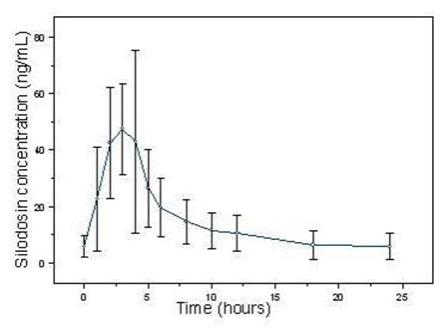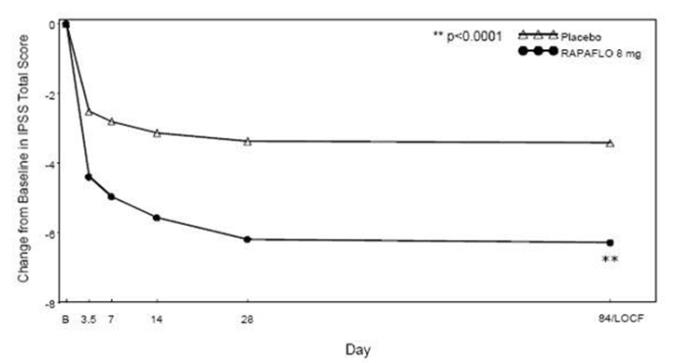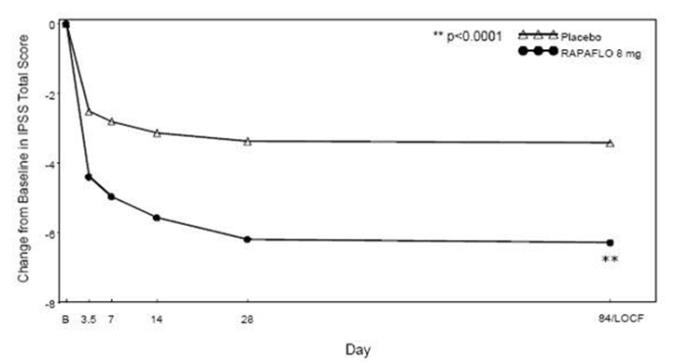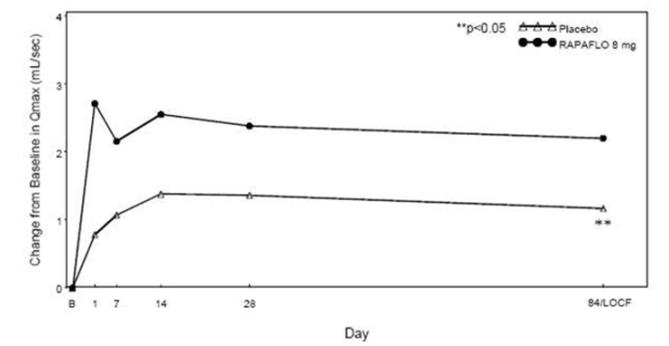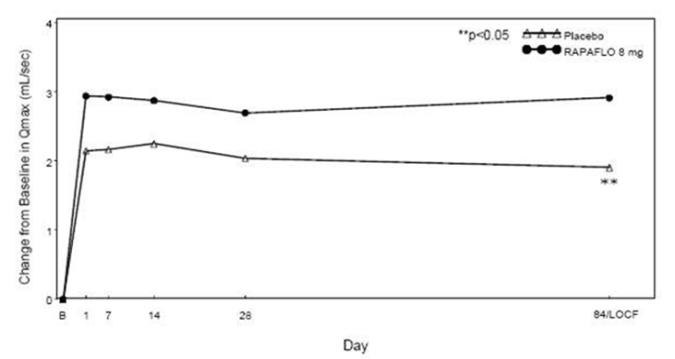RAPAFLO Capsule Ref.[10915] Active ingredients: Silodosin
Source: FDA, National Drug Code (US) Revision Year: 2020
12.1. Mechanism of Action
Silodosin is a selective antagonist of post-synaptic alpha-1 adrenoreceptors, which are located in the human prostate, bladder base, bladder neck, prostatic capsule, and prostatic urethra. Blockade of these alpha-1 adrenoreceptors can cause smooth muscle in these tissues to relax, resulting in an improvement in urine flow and a reduction in BPH symptoms.
An in vitro study examining binding affinity of silodosin to the three subtypes of the alpha-1 adrenoreceptors (alpha-1A, alpha-1B, and alpha-1D) was conducted. The results of the study demonstrated that silodosin binds with high affinity to the alpha-1A subtype.
12.2. Pharmacodynamics
Orthostatic Effects
A test for postural hypotension was conducted 2 to 6 hours after the first dose in the two 12-week, double-blind, placebo-controlled clinical studies. After the patient had been at rest in a supine position for 5 minutes, the patient was asked to stand. Blood pressure and heart rate were assessed at 1 minute and 3 minutes after standing. A positive result was defined as a >30 mmHg decrease in systolic blood pressure, or a >20 mmHg decrease in diastolic blood pressure, or a >20 bpm increase in heart rate [see WARNINGS AND PRECAUTIONS (5.1)].
Table 2. Summary of Orthostatic Test Results in 12-week, Placebo-Controlled Clinical Trials:
| Time of Measurement | Test Result | RAPAFLO N = 466 n (%) | Placebo N = 457 n (%) |
|---|---|---|---|
| 1 Minute After Standing | Negative | 459 (98.7) | 454 (99.6) |
| Positive | 6 (1.3) | 2 (0.4) | |
| 3 Minutes After Standing | Negative | 456 (98.1) | 454 (99.6) |
| Positive | 9 (1.9) | 2 (0.4) |
Cardiac Electrophysiology
The effect of RAPAFLO on QT interval was evaluated in a double-blind, randomized, active-(moxifloxacin) and placebo-controlled, parallel-group study in 189 healthy male subjects aged 18 to 45 years. Subjects received either RAPAFLO 8 mg, RAPAFLO 24 mg, or placebo once daily for five days, or a single dose of moxifloxacin 400 mg on Day 5 only. The 24 mg dose of RAPAFLO was selected to achieve blood levels of silodosin that may be seen in a “worst-case” scenario exposure (i.e., in the setting of concomitant renal disease or use of strong CYP3A4 inhibitors) [see CONTRAINDICATIONS (4), WARNINGS AND PRECAUTIONS (5.3) and CLINICAL PHARMACOLOGY (12.3)]. QT interval was measured during a 24-hour period following dosing on Day 5 (at silodosin steady state).
RAPAFLO was not associated with an increase in individual corrected (QTcI) QT interval at any time during steady state measurement, while moxifloxacin, the active control, was associated with a maximum 9.59 msec increase in QTcI.
There has been no signal of Torsade de Pointes in the post-marketing experience with silodosin outside the United States.
12.3. Pharmacokinetics
The pharmacokinetics of silodosin have been evaluated in adult male subjects with doses ranging from 0.1 mg to 24 mg per day. The pharmacokinetics of silodosin are linear throughout this dosage range.
Absorption
The pharmacokinetic characteristics of silodosin 8 mg once daily were determined in a multi-dose, open-label, 7-day pharmacokinetic study completed in 19 healthy, target-aged (≥45 years of age) male subjects. Table 3 presents the steady state pharmacokinetics of this study.
Table 3. Mean (±SD) Steady State Pharmacokinetic Parameters in Healthy Males Following Silodosin 8 mg Once Daily with Food:
| Cmax (ng/mL) | tmax (hours) | t1/2 (hours) | AUCss (ng•hr/mL) |
|---|---|---|---|
| 61.6 ± 27.54 | 2.6 ± 0.90 | 13.3 ± 8.07 | 373.4 ± 164.94 |
Cmax = maximum concentration, tmax = time to reach Cmax, t1/2 = elimination half-life
AUCss = steady state area under the concentration-time curve
Figure 1. Mean (±SD) Silodosin Steady State Plasma Concentration-Time Profile in Healthy Targ et-Ag ed Subjects Following Silodosin 8 mg Once Daily with Food:
The absolute bioavailability is approximately 32%.
Food Effect
The maximum effect of food (i.e., co-administration with a high fat, high calorie meal) on the PK of silodosin was not evaluated. The effect of a moderate fat, moderate calorie meal was variable and decreased silodosin Cmax by approximately 18 to 43% and AUC by 4 to 49% across three different studies.
In a single-center, open-label, single-dose, randomized, two-period crossover study in twenty healthy male subjects age 21 to 43 years under fed conditions, a study was conducted to evaluate the relative bioavailability of the contents of an 8 mg capsule (size #1) of silodosin sprinkled on applesauce compared to the product administered as an intact capsule. Based on AUC0-24 and Cmax, silodosin administered by sprinkling the contents of a RAPAFLO capsule onto a tablespoonful of applesauce was found to be bioequivalent to administering the capsule whole.
Distribution
Silodosin has an apparent volume of distribution of 49.5 L and is approximately 97% protein bound.
Elimination
Metabolism
Silodosin undergoes extensive metabolism through glucuronidation, alcohol and aldehyde dehydrogenase, and cytochrome P450 3A4 (CYP3A4) pathways. The main metabolite of silodosin is a glucuronide conjugate (KMD-3213G) that is formed via direct conjugation of silodosin by UDP-glucuronosyltransferase 2B7 (UGT2B7). Co-administration with inhibitors of UGT2B7 (e.g., probenecid, valproic acid, fluconazole) may potentially increase exposure to silodosin. KMD-3213G, which has been shown in vitro to be active, has an extended half-life (approximately 24 hours) and reaches plasma exposure (AUC) approximately four times greater than that of silodosin. The second major metabolite (KMD-3293) is formed via alcohol and aldehyde dehydrogenases and reaches plasma exposures similar to that of silodosin. KMD-3293 is not expected to contribute significantly to the overall pharmacologic activity of RAPAFLO.
Excretion
Following oral administration of 14C-labeled silodosin, the recovery of radioactivity after 10 days was approximately 33.5% in urine and 54.9% in feces. After intravenous administration, the plasma clearance of silodosin was approximately 10 L/hour.
Special Populations
Race
No clinical studies specifically investigating the effects of race have been performed.
Geriatric
In a study comparing 12 geriatric males (mean age 69 years) and 9 young males (mean age 24 years), the exposure (AUC) and elimination half-life of silodosin were approximately 15% and 20%, respectively, greater in geriatric than young subjects. No difference in the Cmax of silodosin was observed [see USE IN SPECIFIC POPULATIONS (8.5)].
Pediatric
RAPAFLO has not been evaluated in patients less than 18 years of age.
Renal Impairment
In a study with six subjects with moderate renal impairment, the total silodosin (bound and unbound) AUC, Cmax, and elimination half-life were 3.2-, 3.1-, and 2-fold higher, respectively, compared to seven subjects with normal renal function. The unbound silodosin AUC and Cmax were 2.0- and 1.5-fold higher, respectively, in subjects with moderate renal impairment compared to the normal controls.
In controlled and uncontrolled clinical studies, the incidence of orthostatic hypotension and dizziness was greater in subjects with moderate renal impairment treated with 8 mg RAPAFLO daily than in subjects with normal or mildly impaired renal function [see CONTRAINDICATIONS (4), WARNINGS AND PRECAUTIONS (5.2) and USE IN SPECIFIC POPULATIONS (8.6)].
Hepatic Impairment
In a study comparing nine male patients with moderate hepatic impairment (Child-Pugh scores 7 to 9), to nine healthy male subjects, the single dose pharmacokinetic disposition of silodosin was not significantly altered in the patients with moderate hepatic impairment. No dosing adjustment is required in patients with mild or moderate hepatic impairment. The pharmacokinetics of silodosin in patients with severe hepatic impairment have not been studied [see CONTRAINDICATIONS (4), WARNINGS AND PRECAUTIONS (5.3) and USE IN SPECIFIC POPULATIONS (8.7)].
Drug Interactions
Cytochrome P450 (CYP) 3A4 Inhibitors
Two clinical drug interaction studies were conducted in which a single oral dose of silodosin was co-administered with the strong CYP3A4 inhibitor, ketoconazole, at doses of 400 mg and 200 mg, respectively, once daily for 4 days. Co-administration of 8 mg silodosin with 400 mg ketoconazole led to 3.8-fold increase in silodosin Cmax and 3.2-fold increase in AUC. Co-administration of 4 mg silodosin with 200 mg ketoconazole led to similar increases: 3.7- and 2.9-fold in silodosin Cmax and AUC, respectively. Silodosin is contraindicated with strong CYP3A4 inhibitors.
The effect of moderate CYP3A4 inhibitors on the pharmacokinetics of silodosin has not been evaluated. Due to the potential for increased exposure to silodosin, caution should be exercised when co-administering silodosin with moderate CYP3A4 inhibitors, particularly those that also inhibit P-glycoprotein (e.g., verapamil, erythromycin).
P-glycoprotein (P-gp) Inhibitors
In vitro studies indicated that silodosin is a P-gp substrate. A drug interaction study with a strong P-gp inhibitor has not been conducted. However, in drug interaction studies with ketoconazole, a CYP3A4 inhibitor that also inhibits P-gp, significant increase in exposure to silodosin was observed [see CLINICAL PHARMACOLOGY (12.3)]. Inhibition of P-gp may lead to increased silodosin concentration. Silodosin is not recommended in patients taking strong P-gp inhibitors (e.g., cyclosporine).
Digoxin
The effect of silodosin on the pharmacokinetics of digoxin was evaluated in a multiple dose, single-sequence, crossover study of 16 healthy males, aged 18 to 45 years. A loading dose of digoxin was administered as 0.5 mg twice daily for one day. Following the loading doses, digoxin (0.25 mg once daily) was administered alone for seven days and then concomitantly with silodosin 4 mg twice a day for the next seven days. No significant differences in digoxin AUC and Cmax were observed when digoxin was administered alone or concomitantly with silodosin.
Other Metabolic Enzymes and Transporters
In vitro studies indicated that silodosin administration is not likely to inhibit the activity of CYP1A2, CYP2A6, CYP2C9, CYP2C19, CYP2D6, CYP2E1, and CYP3A4 or induce the activity of CYP1A2, CYP2C8, CYP2C9, CYP2C19, CYP3A4, and P-gp.
13.1. Carcinogenesis, Mutagenesis, Impairment of Fertility
In a 2-year oral carcinogenicity study in rats administered doses up to 150 mg/kg/day [about 8 times the exposure at the MRHD based on AUC of silodosin], an increase in thyroid follicular cell tumor incidence was seen in male rats receiving doses of 150 mg/kg/day. Silodosin induced stimulation of thyroid stimulating hormone (TSH) secretion in the male rat as a result of increased metabolism and decreased circulating levels of thyroxine (T4). These changes are believed to produce specific morphological and functional changes in the rat thyroid including hypertrophy, hyperplasia, and neoplasia. Silodosin did not alter TSH or T4 levels in clinical trials and no effects based on thyroid examinations were noted. The relevance to human risk of these thyroid tumors in rats is not known.
In a 2-year oral carcinogenicity study in mice administered doses up to 100 mg/kg/day in males (about 9 times the exposure at the MRHD based on AUC of silodosin) and 400 mg/kg/day in females (about 72 times the exposure at the MRHD based on AUC), there were no significant tumor findings in male mice. Female mice treated for 2 years with doses of 150 mg/kg/day (about 29 times the exposure at the MRHD based on AUC) or greater had statistically significant increases in the incidence of mammary gland adenoacanthomas and adenocarcinomas. The increased incidence of mammary gland neoplasms in female mice was considered secondary to silodosin-induced hyperprolactinemia measured in the treated mice. Elevated prolactin levels were not observed in clinical trials. The relevance to human risk of prolactin-mediated endocrine tumors in mice is not known. Rats and mice do not produce glucuronidated silodosin, which is present in human serum at approximately four times the level of circulating silodosin and which has similar pharmacological activity to silodosin.
Silodosin produced no evidence of mutagenic or genotoxic potential in the in vitro Ames assay, mouse lymphoma assay, unscheduled DNA synthesis assay and the in vivo mouse micronucleus assay. A weakly positive response was obtained in two in vitro Chinese Hamster Lung (CHL) tests for chromosomal aberration assays at high, cytotoxic concentrations.
Treatment of male rats with silodosin for 15 days resulted in decreased fertility at the high dose of 20 mg/kg/day (about 2 times the exposure at the MRHD based on AUC) which was reversible following a two-week recovery period. No effect was observed at 6 mg/kg/day. The clinical relevance of this finding is not known.
In a fertility study in female rats, the high dose of 20 mg/kg/day (about 1 to 4 times the exposure at the MRHD based on AUC) resulted in estrus cycle changes, but no effect on fertility. No effect on the estrus cycle was observed at 6 mg/kg/day.
In a male rat fertility study, sperm viability and count were significantly lower after administration of 600 mg/kg/day (about 65 times the exposure at the MRHD based on AUC) for one month. Histopathological examination of infertile males revealed changes in the testes and epididymides at 200 mg/kg/day (about 30 times the exposure at the MRHD based on AUC).
14. Clinical Studies
14.1 Benign Prostatic Hyperplasia
Two 12-week, randomized, double-blind, placebo-controlled, multicenter studies were conducted with 8 mg daily of silodosin. In these two studies, 923 patients [mean age 64.6 years; Caucasian (89.3%), Hispanic (4.9%), Black (3.9%), Asian (1.2%), Other (0.8%)] were randomized and 466 patients received RAPAFLO 8 mg daily. The two studies were identical in design except for the inclusion of pharmacokinetic sampling in Study 1. The primary efficacy assessment was the International Prostate Symptom Score (IPSS) which evaluated irritative (frequency, urgency, and nocturia), and obstructive (hesitancy, incomplete emptying, intermittency, and weak stream) symptoms. Maximum urine flow rate (Qmax) was a secondary efficacy measure.
Mean changes from baseline to last assessment (Week 12) in total IPSS score were statistically significantly greater for groups treated with RAPAFLO than those treated with placebo in both studies (Table 4 and Figures 2 and 3).
Table 4. Mean Change (SD) from Baseline to Week 12 in International Prostate Symptom Score in Two Randomized, Controlled, Double-Blind Studies:
| Total Symptom Score | Study 1 | Study 2 | ||||
|---|---|---|---|---|---|---|
| RAPAFLO 8 mg (n = 233) | Placebo (n = 228) | p-value | RAPAFLO 8 mg (n = 233) | Placebo (n = 229) | p-value | |
| Baseline | 21.5 (5.38) | 21.4 (4.91) | 21.2 (4.88) | 21.2 (4.92) | ||
| Week 12 / LOCF Change from Baseline | -6.5 (6.73) | -3.6 (5.85) | <0.0001 | -6.3 (6.54) | -3.4 (5.83) | <0.0001 |
LOCF – Last observation carried forward for those not completing 12 weeks of treatment
Figure 2. Mean Change from Baseline in IPSS Total Score by Treatment Group and Visit in Study 1:
B – Baseline determination taken Day 1 of the study before the initial dose. Subsequent values are observed cases except for LOCF values.
LOCF – Last observation carried forward for those not completing 12 weeks of treatment.
Figure 3. Mean Change from Baseline in IPSS Total Score by Treatment Group and Visit in Study 2:
B – Baseline determination taken Day 1 of the study before the initial dose. Subsequent values are observed cases except for LOCF values.
LOCF – Last observation carried forward for those not completing 12 weeks of treatment.
Mean IPSS total score for RAPAFLO once daily groups showed a decrease starting at the first scheduled observation and remained decreased through the 12 weeks of treatment in both studies.
RAPAFLO produced statistically significant increases in maximum urinary flow rates from baseline to last assessment (Week 12) versus placebo in both studies (Table 5 and Figures 4 and 5). Mean peak flow rate increased starting at the first scheduled observation at Day 1 and remained greater than the baseline flow rate through the 12 weeks of treatment for both studies.
Table 5. Mean Change (SD) from Baseline in Maximum Urinary Flow Rate (mL/sec) in Two Randomized, Controlled, Double-Blind Studies:
| Mean Maximum Flow Rate (mL/sec) | Study 1 | Study 2 | ||||
|---|---|---|---|---|---|---|
| RAPAFLO 8 mg (n = 233) | Placebo (n = 228) | p-value | RAPAFLO 8 mg (n = 233) | Placebo (n = 229) | p-value | |
| Baseline | 9.0 (2.60) | 9.0 (2.85) | 8.4 (2.48) | 8.7 (2.67) | ||
| Week 12 / LOCF Change from Baseline | 2.2 (4.31) | 1.2 (3.81) | 0.0060 | 2.9 (4.53) | 1.9 (4.82) | 0.0431 |
LOCF – Last observation carried forward for those not completing 12 weeks of treatment.
Figure 4. Mean Change from Baseline in Qmax (mL/sec) by Treatment Group and Visit in Study 1:
B – Baseline determination taken Day 1 of the study before the initial dose. Subsequent values are observed cases except for LOCF values.
LOCF – Last observation carried forward for those not completing 12 weeks of treatment.
Note – The first Qmax assessments at Day 1 were taken 2 to 6 hours after patients received the first dose of double-blind medication.
Note – Measurements at each visit were scheduled 2 to 6 hours after dosing (approximate peak plasma silodosin concentration).
Figure 5. Mean Change from Baseline in Qmax (mL/sec) by Treatment Group and Visit in Study 2:
B – Baseline determination taken Day 1 of the study before the initial dose. Subsequent values are observed cases except for LOCF values.
LOCF – Last observation carried forward for those not completing 12 weeks of treatment.
Note – The first Qmax assessments at Day 1 were taken 2 to 6 hours after patients received the first dose of double-blind medication.
Note – Measurements at each visit were scheduled 2 to 6 hours after dosing (approximate peak plasma silodosin concentration).
© All content on this website, including data entry, data processing, decision support tools, "RxReasoner" logo and graphics, is the intellectual property of RxReasoner and is protected by copyright laws. Unauthorized reproduction or distribution of any part of this content without explicit written permission from RxReasoner is strictly prohibited. Any third-party content used on this site is acknowledged and utilized under fair use principles.
